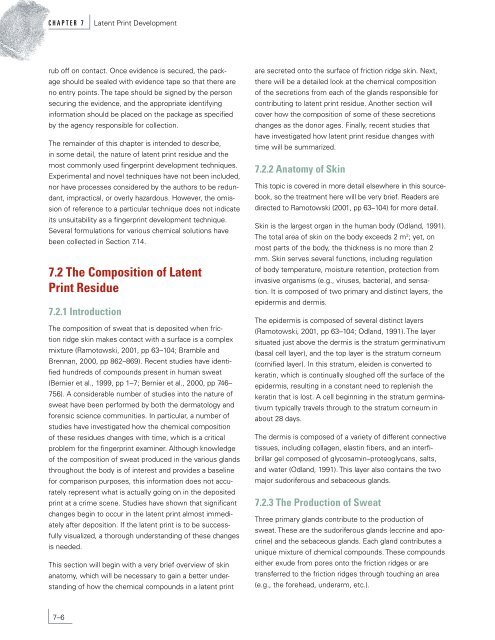Latent Print Development - National Criminal Justice Reference ...
Latent Print Development - National Criminal Justice Reference ...
Latent Print Development - National Criminal Justice Reference ...
You also want an ePaper? Increase the reach of your titles
YUMPU automatically turns print PDFs into web optimized ePapers that Google loves.
C H A P T E R 7 <strong>Latent</strong> <strong>Print</strong> <strong>Development</strong><br />
rub off on contact. Once evidence is secured, the pack-<br />
age should be sealed with evidence tape so that there are<br />
no entry points. The tape should be signed by the person<br />
securing the evidence, and the appropriate identifying<br />
information should be placed on the package as specified<br />
by the agency responsible for collection.<br />
The remainder of this chapter is intended to describe,<br />
in some detail, the nature of latent print residue and the<br />
most commonly used fingerprint development techniques.<br />
Experimental and novel techniques have not been included,<br />
nor have processes considered by the authors to be redun-<br />
dant, impractical, or overly hazardous. However, the omis-<br />
sion of reference to a particular technique does not indicate<br />
its unsuitability as a fingerprint development technique.<br />
Several formulations for various chemical solutions have<br />
been collected in Section 7.14.<br />
7.2 The Composition of <strong>Latent</strong><br />
<strong>Print</strong> Residue<br />
7.2.1 Introduction<br />
The composition of sweat that is deposited when fric-<br />
tion ridge skin makes contact with a surface is a complex<br />
mixture (Ramotowski, 2001, pp 63–104; Bramble and<br />
Brennan, 2000, pp 862–869). Recent studies have identi-<br />
fied hundreds of compounds present in human sweat<br />
(Bernier et al., 1999, pp 1–7; Bernier et al., 2000, pp 746–<br />
756). A considerable number of studies into the nature of<br />
sweat have been performed by both the dermatology and<br />
forensic science communities. In particular, a number of<br />
studies have investigated how the chemical composition<br />
of these residues changes with time, which is a critical<br />
problem for the fingerprint examiner. Although knowledge<br />
of the composition of sweat produced in the various glands<br />
throughout the body is of interest and provides a baseline<br />
for comparison purposes, this information does not accu-<br />
rately represent what is actually going on in the deposited<br />
print at a crime scene. Studies have shown that significant<br />
changes begin to occur in the latent print almost immedi-<br />
ately after deposition. If the latent print is to be success-<br />
fully visualized, a thorough understanding of these changes<br />
is needed.<br />
This section will begin with a very brief overview of skin<br />
anatomy, which will be necessary to gain a better under-<br />
standing of how the chemical compounds in a latent print<br />
7–6<br />
are secreted onto the surface of friction ridge skin. Next,<br />
there will be a detailed look at the chemical composition<br />
of the secretions from each of the glands responsible for<br />
contributing to latent print residue. Another section will<br />
cover how the composition of some of these secretions<br />
changes as the donor ages. Finally, recent studies that<br />
have investigated how latent print residue changes with<br />
time will be summarized.<br />
7.2.2 Anatomy of Skin<br />
This topic is covered in more detail elsewhere in this source-<br />
book, so the treatment here will be very brief. Readers are<br />
directed to Ramotowski (2001, pp 63–104) for more detail.<br />
Skin is the largest organ in the human body (Odland, 1991).<br />
The total area of skin on the body exceeds 2 m 2 ; yet, on<br />
most parts of the body, the thickness is no more than 2<br />
mm. Skin serves several functions, including regulation<br />
of body temperature, moisture retention, protection from<br />
invasive organisms (e.g., viruses, bacteria), and sensa-<br />
tion. It is composed of two primary and distinct layers, the<br />
epidermis and dermis.<br />
The epidermis is composed of several distinct layers<br />
(Ramotowski, 2001, pp 63–104; Odland, 1991). The layer<br />
situated just above the dermis is the stratum germinativum<br />
(basal cell layer), and the top layer is the stratum corneum<br />
(cornified layer). In this stratum, eleiden is converted to<br />
keratin, which is continually sloughed off the surface of the<br />
epidermis, resulting in a constant need to replenish the<br />
keratin that is lost. A cell beginning in the stratum germina-<br />
tivum typically travels through to the stratum corneum in<br />
about 28 days.<br />
The dermis is composed of a variety of different connective<br />
tissues, including collagen, elastin fibers, and an interfi-<br />
brillar gel composed of glycosamin–proteoglycans, salts,<br />
and water (Odland, 1991). This layer also contains the two<br />
major sudoriferous and sebaceous glands.<br />
7.2.3 The Production of Sweat<br />
Three primary glands contribute to the production of<br />
sweat. These are the sudoriferous glands (eccrine and apo-<br />
crine) and the sebaceous glands. Each gland contributes a<br />
unique mixture of chemical compounds. These compounds<br />
either exude from pores onto the friction ridges or are<br />
transferred to the friction ridges through touching an area<br />
(e.g., the forehead, underarm, etc.).

















